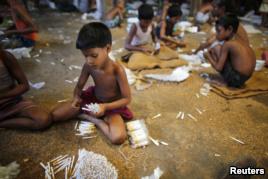
Doctors have been warning for years that secondhand smoke leads to many types of illness. However, many children around the world live in areas where adults regularly smoke.
Journal Annals of Family Medicine recently published an article calling for doctors to start treating children’s contact with secondhand smoke as abuse. In that case, contact to secondhand smoke would be viewed much like physical abuse or neglect. The article says secondhand smoke causes many diseases in children. The article adds that no amount of secondhand smoke is safe.
The U.S. Centers for Disease Control and Prevention agree that secondhand smoke can cause serious health problems in children. They say that compared to children who grow up in homes without smokers, children with parents who smoke have smaller lungs and more illnesses.
However, several organizations for smokers’ rights in the U.S. say people have the right to smoke in their own homes. They say that many studies done on the effects of smoking on health, including studies on secondhand smoke, do not use good science.
The article about secondhand smoke and children comes at the same time the World Health Organization calls to fight against tobacco companies. Dr. Margaret Chan, director-general of the organization, says tobacco companies are trying to avoid and even weaken anti-tobacco laws. She warned the fight against tobacco companies is going to be difficult. But she added, “We should not give up until we make sure the tobacco industry goes out of business.”
Other leading public health researchers at the conference called for the sale of tobacco to end by 2040.
Those who want to see a tobacco-free world say they hope that in twenty years “only five percent of adults around the world will still smoke. A world where tobacco is out of sight, out of mind, and out of fashion—yet not prohibited—is achievable in less than two decades from now.” However, they say, such a world will need the full commitment from governments, civil society and international agencies.
本时文内容由奇速英语国际教育研究院原创编写,禁止复制和任何商业用途,版权所有,侵权必究!
1.What’s the purpose of the article published in Annals of Family Medicine?
A To warn people of the dangers of secondhand smoke.
B To require the doctors to ban sales of tobacco by 2040.
C To ask the parents not to smoke in their houses any more.
D To help reduce children’s exposure to secondhand smoke.
解析:选D。D 推理判断题。根据文章第二段的“calling for doctors to start treating children’s contact with secondhand smoke as abuse”可知,该文要求医生 将让儿童接触二手烟的行为视为虐待儿童,也就 是为了帮助儿童减少接触二手烟。故选 D。
2. How were the children in homes with smokers?
A They had almost no lungs.
B They fell sick more often.
C They had breathing problems.
D They were physically abused or neglected.
解析:选B。B 细节理解题。根据文章第三段的“children with parents who smoke have smaller lungs and more illnesses”可知,那些父母吸烟的儿童肺部器官发 育较小,而且多病。故选 B。
3.What’s Margaret Chan’s attitude toward tobacco companies?
A Supportive.
B Optimistic.
C Critical.
D Objective.
解析:选C。C 推理判断题。根据文章第五段第一句的“fight against tobacco companies”以及最后一句的“We should not give up until we make sure the tobacco industry goes out of business”可知,她反对烟草公 司,即批判的。故选 C。
4.What do we know from the last paragraph?
A Some people are confident to make a tobacco-free world.
B With the government’s efforts smoking can be prohibited.
C Smoking will be no longer fashionable in twenty years.
D People will not know what tobacco is in twenty years.
解析:选A。A 推理判断题。根据文章最后一段的“Those who want to see a tobacco-free world...” 和 “A world where tobacco is… achievable in less than two decades from now”可知,二十年之后人们将迎来 一个无烟的世界。由此判断,有些人有信心创造 一个无烟世界。故选 A。